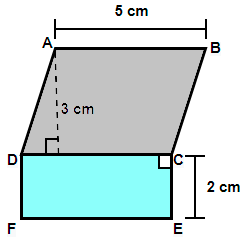
In the diagram shown, ABCD is a parallelogram and CDEF is a rectangle. The total area of the whole figure is?

(a) 35 $c{{m}^{2}}$
(b) 30 $c{{m}^{2}}$
(c) 25 $c{{m}^{2}}$
(d) 20 $c{{m}^{2}}$

Answer
505.2k+ views
Hint: First find the area of the trapezium by using the formula Area = $b\times h$ where b is the base and h is the height. Take the base as CD and use the property that the opposite sides of a parallelogram are equal to write CD = AB = 5 cm. Take the height (h) = 3 cm. Now, to find the area of the rectangle use the formula Area = $L\times B$ where B is the breadth and L is the length. Take length (L) = 5 cm and breadth (B) = 2 cm. Take the sum of the areas calculated to get the answer.
Complete step by step answer:
Here we have been provided with the figure shown below in which ABCD is a parallelogram and CDEF is a rectangle. We have been asked to find the total area of the whole figure. Let us calculate the area of both the figures one by one.
(1) Considering the parallelogram ABCD we have the height of the parallelogram (say h) given as 3 cm. Also, we know that the opposite sides of a parallelogram are equal, so we have CD = AB = 5 cm. CD can be considered as the base (say b) of the parallelogram, we know that the area of a parallelogram is $b\times h$, so we get,
$\Rightarrow $ Area of parallelogram ABCD = $5\times 3$
$\Rightarrow $ Area of parallelogram ABCD = 15 $c{{m}^{2}}$
(2) Considering the rectangle CDEF we can consider CD as the length (say L) of the rectangle and CF as the breadth (say B) of the rectangle. So from the given figure we have L = 5 cm and B = 2 cm, we know that the area of a rectangle is $L\times B$, so we get,
$\Rightarrow $ Area of rectangle CDEF = $5\times 2$
$\Rightarrow $ Area of rectangle CDEF = 10 $c{{m}^{2}}$
Therefore, the total area of the whole figure is the sum of the area of parallelogram and that of the rectangle, so we get,
$\Rightarrow $ Total Area of the whole figure = 15 $c{{m}^{2}}$ + 10 $c{{m}^{2}}$
$\therefore $ Total Area of the whole figure = 25 $c{{m}^{2}}$
So, the correct answer is “Option c”.
Note: You must remember the formulas of area and perimeter of certain important 2 – D shapes like square, rectangle, rhombus, trapezium, parallelogram etc. as they are often used in chapter ‘area and perimeter’. Also, remember the properties of these shapes or otherwise it will be difficult to find the length of the rectangle in the above question.
Complete step by step answer:
Here we have been provided with the figure shown below in which ABCD is a parallelogram and CDEF is a rectangle. We have been asked to find the total area of the whole figure. Let us calculate the area of both the figures one by one.
(1) Considering the parallelogram ABCD we have the height of the parallelogram (say h) given as 3 cm. Also, we know that the opposite sides of a parallelogram are equal, so we have CD = AB = 5 cm. CD can be considered as the base (say b) of the parallelogram, we know that the area of a parallelogram is $b\times h$, so we get,
$\Rightarrow $ Area of parallelogram ABCD = $5\times 3$
$\Rightarrow $ Area of parallelogram ABCD = 15 $c{{m}^{2}}$
(2) Considering the rectangle CDEF we can consider CD as the length (say L) of the rectangle and CF as the breadth (say B) of the rectangle. So from the given figure we have L = 5 cm and B = 2 cm, we know that the area of a rectangle is $L\times B$, so we get,
$\Rightarrow $ Area of rectangle CDEF = $5\times 2$
$\Rightarrow $ Area of rectangle CDEF = 10 $c{{m}^{2}}$
Therefore, the total area of the whole figure is the sum of the area of parallelogram and that of the rectangle, so we get,
$\Rightarrow $ Total Area of the whole figure = 15 $c{{m}^{2}}$ + 10 $c{{m}^{2}}$
$\therefore $ Total Area of the whole figure = 25 $c{{m}^{2}}$
So, the correct answer is “Option c”.
Note: You must remember the formulas of area and perimeter of certain important 2 – D shapes like square, rectangle, rhombus, trapezium, parallelogram etc. as they are often used in chapter ‘area and perimeter’. Also, remember the properties of these shapes or otherwise it will be difficult to find the length of the rectangle in the above question.
Recently Updated Pages
What happens to glucose which enters nephron along class 10 biology CBSE

Write a dialogue with at least ten utterances between class 10 english CBSE

A circle is inscribed in an equilateral triangle and class 10 maths CBSE

When the JanmiKudian Act was passed that granted the class 10 social science CBSE

A sector containing an angle of 120 circ is cut off class 10 maths CBSE

The sum of digits of a two digit number is 13 If t-class-10-maths-ICSE

Trending doubts
The shortest day of the year in India

Why is there a time difference of about 5 hours between class 10 social science CBSE

Write a letter to the principal requesting him to grant class 10 english CBSE

What is the median of the first 10 natural numbers class 10 maths CBSE

The Equation xxx + 2 is Satisfied when x is Equal to Class 10 Maths

What is the missing number in the sequence 259142027 class 10 maths CBSE




